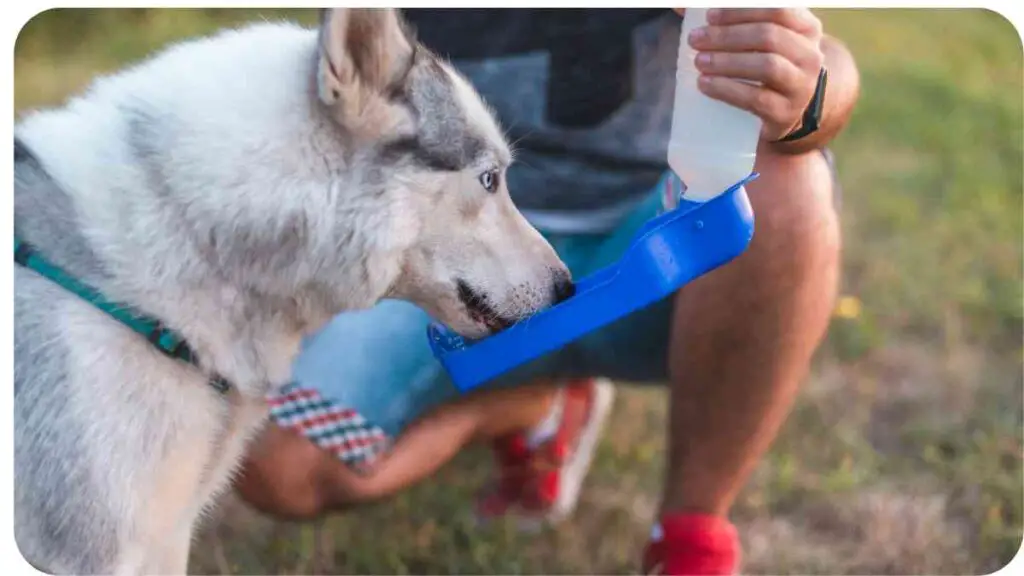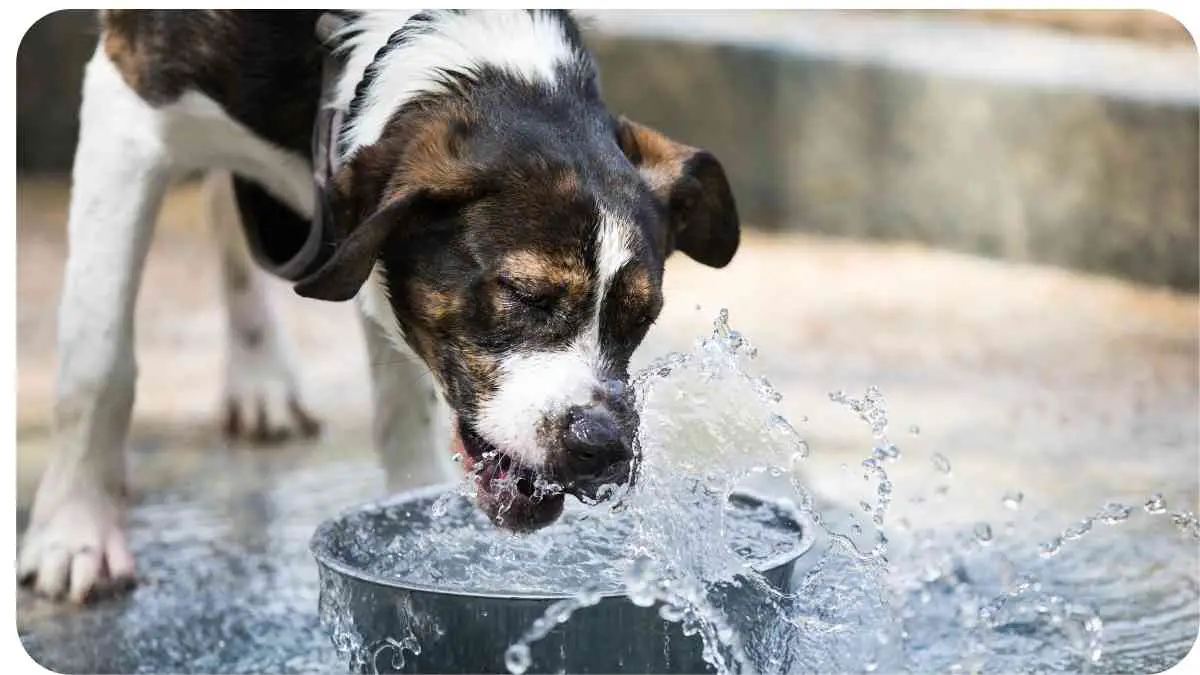Ever wondered how much of your furry friend’s body weight is made up of water? You’re not alone! Understanding this can be crucial for ensuring your dog’s health and well-being. Just like in humans, water plays a vital role in maintaining a dog’s bodily functions. In this article, we’ll dive into how much of a dog’s body is water, why it’s important, and how you can ensure your dog stays well-hydrated.
| Key Takeaways |
|---|
| Dogs’ bodies are about 60-70% water, crucial for their health. |
| Proper hydration helps regulate body temperature, aids digestion, and nutrient absorption. |
| Puppies have higher water content compared to adults, and senior dogs have less. |
| Ensure your dog drinks about 1 ounce of water per pound of body weight daily. |
| Dehydration signs include dry gums, lethargy, and sunken eyes. |
| Offer fresh water daily, use multiple bowls, and consider adding flavors like low-sodium broth. |
| Wet food can contribute to hydration but should not replace water. |
| Special attention is needed for puppies, senior dogs, and dogs with health conditions. |
Why Is Water Important for Dogs?

Water isn’t just a thirst-quencher for dogs; it’s essential for their survival. It helps regulate their body temperature, aids in digestion, and ensures that nutrients are properly absorbed. Think of water as the lubricant that keeps all the gears in your dog’s body running smoothly. Without it, things could start to grind to a halt.
If you’re concerned about heartworm infections in your dog, it’s crucial to explore effective treatments for heartworms in dogs. Ensuring prompt and appropriate care can greatly impact your pet’s recovery and overall health.
How Much Water Is in a Dog’s Body?
Water Content by Dog Size
The percentage of water in a dog’s body can vary based on size and other factors. Generally, most dogs have about 60-70% water content. However, this can differ based on their breed and body composition.
| Dog Size | Approximate Water Content |
|---|---|
| Small Breeds | 60-65% |
| Medium Breeds | 65-70% |
| Large Breeds | 70% or more |
Water Content by Age
Age also plays a role in how much water is in a dog’s body. Puppies have higher water content compared to adult dogs, while older dogs may have slightly less.
When managing your dog’s pain, choosing the best medication is critical. Explore what’s the best pain medicine for a dog to make informed decisions for their well-being.
| Age Group | Approximate Water Content |
|---|---|
| Puppies | 70-75% |
| Adults | 60-70% |
| Seniors | 55-65% |
Factors Affecting Water Content
Breed Differences
Different breeds have varying water content levels. For instance, dogs with higher muscle mass might have more water content compared to those with higher fat percentages.
Health and Hydration Levels
A dog’s health can significantly impact their hydration levels. Illnesses, medications, and overall health status can affect how much water their body retains.
How to Ensure Your Dog Gets Enough Water

Signs of Dehydration
Keeping an eye out for signs of dehydration is crucial. Common symptoms include dry gums, lethargy, and sunken eyes. If you notice these signs, it’s essential to get your dog hydrated immediately.
Addressing a yeast infection on your dog’s paw is essential for their comfort. Learn how to treat a yeast infection on your dog’s paw to provide relief and prevent further issues.
How Much Water Should Your Dog Drink?
The general rule is that a dog should drink about 1 ounce of water per pound of body weight daily. However, this can vary depending on activity level, diet, and overall health.
Tips for Encouraging Water Intake
Here are some tips to help your dog drink more water:
- Fresh and Clean Water: Always provide fresh water.
- Multiple Water Bowls: Place water bowls in different areas of the house.
- Add Flavor: Try adding a splash of low-sodium broth to the water.
The Role of Water in Your Dog’s Diet
Wet vs. Dry Food
Wet food can contribute to your dog’s daily water intake, whereas dry food has minimal water content. Balancing wet and dry food can help ensure adequate hydration.
Homemade Dog Food and Water Content
If you’re preparing homemade meals for your dog, consider the water content of the ingredients. Incorporating water-rich foods can help maintain your dog’s hydration levels.
Feeding your Alsatian the right diet is important. Discover the best food for Alsatian dogs to ensure they receive the proper nutrition for their health and vitality.
Special Considerations
Puppies and Senior Dogs
Puppies and senior dogs have unique hydration needs. Puppies generally need more water for their rapid growth, while senior dogs may require more frequent water intake to support aging organs.
Dogs with Health Conditions
Dogs with certain health conditions, such as kidney disease or diabetes, might need more careful monitoring of their water intake. Regular vet check-ups can help manage their hydration needs.
Understanding how much food your 15-pound dog needs is key to maintaining their health. Find out how much food should a 15-pound dog have a day to provide the right amount of nourishment.
Conclusion
Water is a fundamental component of your dog’s health, playing a role in nearly every bodily function. By understanding how much water is in your dog’s body and taking steps to ensure they stay hydrated, you’re contributing to their overall well-being.
Further Reading
How Much Water Should Dogs and Cats Drink?
This article from Hill’s Pet provides a comprehensive guide on the water needs of both dogs and cats. It covers general hydration guidelines and practical tips for ensuring your pets stay well-hydrated.
How Much Water Should a Dog Drink?
GoodRx offers a clear and concise overview of how much water dogs need based on their size, age, and activity level. It also includes helpful advice on monitoring your dog’s hydration.
The Importance of Water for Dogs
PetMD discusses why water is crucial for your dog’s health and explores the various benefits of proper hydration. The article also includes tips for ensuring your dog gets enough water.
FAQs
What are the signs of dehydration in dogs?
Dehydration in dogs can be indicated by dry gums, sunken eyes, lethargy, and a lack of elasticity in the skin. If you notice these signs, offer water immediately and consult your veterinarian.
How much water should a dog drink daily?
A dog should generally drink about 1 ounce of water per pound of body weight each day. This amount can vary based on the dog’s size, activity level, and diet.
Can wet food substitute for drinking water?
While wet food contains moisture and contributes to your dog’s hydration, it should not replace fresh drinking water. Always provide a clean water source for your dog.
How can I encourage my dog to drink more water?
To encourage your dog to drink more water, ensure it is fresh and clean, place multiple water bowls around the house, and consider adding a splash of low-sodium broth for flavor.
Do different breeds require different amounts of water?
Most dogs follow the general guideline of 1 ounce of water per pound of body weight, but larger or more active breeds may need more water. Always adjust based on your dog’s specific needs and consult your vet if unsure.

I am Dr Hellen James a veterinarian, pet lover, and writer. I have many years of experience caring for pets, including dogs, cats, birds, and fish (and even axolotls!). I love spending time with the animals in my life, especially when they are sick or need love.

